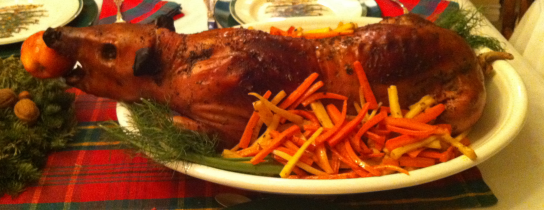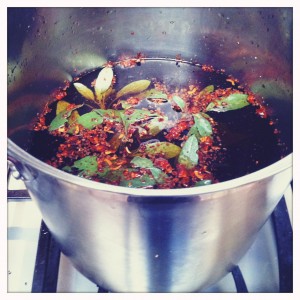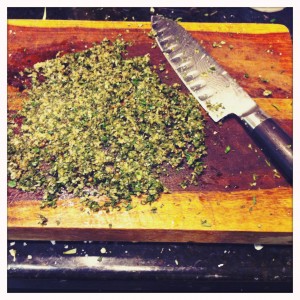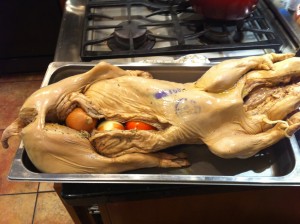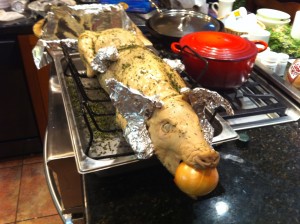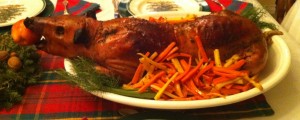I spent the better part of Christmas week worrying about one thing. A baby pig. Specifically, a suckling pig. Would it arrive in time for Christmas (I ordered it from a farm in Arizona, and I live in Southern California)? Would it fit it my oven? Would it thaw out properly? Would I have to send my dinner guests out for McDonalds after botching this whole pig thing?
Fast forward a few days, and I am happy to report that everything turned out better than expected. No major disasters. There are little things I might do differently next time, but “Babe,” as I took to calling her, was without a doubt the star of Christmas evening.
Here is the breakdown of what I did, in case you are thinking of doing it yourself some time.
Sourcing the pig: I am not compulsive locavore, though I think it’s great to support local growers and farmers when it makes sense. I went to the internet to try and find a source for an uncooked suckling pig in the LA area. The only place I could find locally was Huntington Meats at the Fairfax Farmer’s Market. I decided to call them before driving up there, as well as sending an e-mail. Didn’t get any response. I am sure they had bigger, umm, fish to fry since I contacted them only six days before Christmas.
Back to the internet, where I happened upon McReynolds Farms out of Arizona. They sell suckling picks, ship all over the U.S. and only need a moment’s notice. Sold. Order placed.
Prepping the pig: My UPS delivery showed up as requested on December 23. Actually before I figured out what I was going to do with Babe. Where I was going to store her. What I was going to cook her in. How I was going to cook her. Crud. While Babe was thawing in the entry way of my house, I quickly took to the interweb looking for recipe ideas. I settled on brining her in this solution:
[T-minus 48 hours]
SUCKLING PIG BRINE
Please note, these instructions assume that your pig arrived frozen.
Equipment:
*A container pig enough to hold the brining liquid and the pig.
*A large trash bag (big enough to hold the liquid and the pig).
*20 lbs. of ice for keeping the pig cold.
Ingredients:
A 16 lb. suckling pig
2 gallons apple cider vinegar
2 cups kosher salt
2 cups sugar
1 cup pink peppercorns, crushed
2 handfuls fresh sage
10 whole star anise
12 cups ice
4 cups cold water
Directions:
1. Combine vinegar, sugar, salt in a large stock pot. Place on the stove on medium-high heat. Stir until sugar and salt melt. Add ice, peppercorns, sage and anise. The mixture should cool off rather quickly due to the ice. Make sure its completely cool before covering the pig with it.
2. (My refrigerator was not big enough to store the pig in, so I decided to sandwich it between two 10 gallon ice bags. I used the Styrofoam cooler that it was shipped in, and that worked just fine for storing the pig until I was ready to cook it). Thoroughly rinse the pig off before placing it in the brine. Pour the brine into your large plastic bag, then add the pig. Make sure the pig is fully submerged. Drape the edge of the plastic bag over the side of the cooler and lay the bag inside the cooler. Sandwich the bag with ice if you aren’t able to refrigerate the pig. Place the lid on the cooler. Rotate the pig every three hours. Make sure the temperature is 40 degrees-F or lower for the duration of the time you are storing the pig.
[T-minus 12 hours]
3. If storing in a cooler it’s time to start thawing the pig. Remove the ice bags from the cooler. Replace the lid. Continue to let the pig sit in the brine while it thaws.
[T-minus 5 hours]
4. Prepare the pig for cooking. Remove the pig from the brine. And pat until thoroughly dry with a clean dish towel.
5. Prepare herb/salt rub. (Trito in Italian.)
TRITO & TRUSSING
Equipment:
*Trussing needle
*Kitchen string
*Aluminum foil
*Roasting pan
Ingredients:
1 head of garlic, chopped superfine and mashed into a paste
1.75 ounces of coarse salt
1 ounce coarsely ground black pepper, finely chopped
1 ounce of fresh rosemary leaves, finely chopped
1 ounce fresh sage leaves, finely chopped
Olive oil
2 apples
3 onions
6. Combine the first five ingredients in a bowl. Place the pig belly down in the roasting pan. Rub generously with olive oil. Take 1/2 of the trito and, using your hands, spread it over the surface of the pig. Flip the pig over and repeat process. Be sure to rub some trito into the cavity of the pig as well.
7. Place 2 apples and 2 onions (more if necessary) into the cavity of the pig. This will help the pig to keep its shape while its cooking. Place a small onion or apple in the pigs mouth. This will help keep the mouth open during cooking if you later want to present it with an apple in its mouth. Otherwise, I think the jaw will be cooked shut. Cover the hooves, ears and tail with aluminum foil, or they will char in the cooking process.
8. Thread the trussing needle with kitchen string and truss the pigs stomach in the same way that you would sew a garment. Make sure the string is pulled tight and knotted to finish. Point the pigs front and hind legs forward and truss them close to its body (mine came already trussed.) Now the pig is ready for cooking.
[T-minus 4 hours]
ROASTING THE PIG
*Equipment needed:
*Roasting pan
*Baster
*Meat thermometer
9. (Based upon my research, I misoverestimated the time it would take to roast my pig in the oven. I thought it would take about 30 minutes per pound. It took just about half of that, closer to 15 minutes a pound.) Preheat the oven to 400 degrees-F. Once the oven comes up to temperature, place the pig in the oven at 400 degrees-F for 20 minutes. Turn the oven down to 350 degrees-F and cook the pig until a meat thermometer registers just under 160 degrees-F. Baste pig with its drippings once an hour. (The “hip” joints will be the last places on the pig to come up to temperature.) Remove the pig from the oven and let rest for 15 minutes before slicing. (The pig will continue to cook in the first several minutes after being removed from the oven).
10. Carve and serve.
Serves: 10
A couple of random thoughts:
*Cost for this baby, including shipping was ~$200.
*Next time I would consider starting the pig at 350 degrees-F and cranking up the temp the last 20 minutes to 500-degrees F crisp up the skin. We did get some nice crisp bits of skin, but only in select places.
*SUPER IMPORTANT: Before you order a pig, make sure you have a big enough pan to roast it in, and measure your oven to make sure it’s big enough to fit a suckling pig. Our pig was 25″ long, and we got her to fit in a 22″ hotel pan that we had in our pantry, but some roasting pans are more expensive than buying a pig. We got her to fit sideways in our oven by scrunching up her snout a bit against the side panel of the oven.
–StellaCadente*
Follow me on Twitter @pomodorista


